*a note on content: this essay contains nudity and references assault and rape*
We are on the beach in a city that both of us once lived in. It’s 5 AM. We’ve only had three hours of sleep after visiting with friends late into the night, but here we are, determined to get the perfect sunrise light. Tenille makes a sleep-deprived joke that seems much funnier at the moment than I can explain it now, about me being a pigeon that needs to learn to be an eagle, like her. “Be an Eagle!” she keeps saying, as we walk out to the water, me getting ready to strip down for her camera.
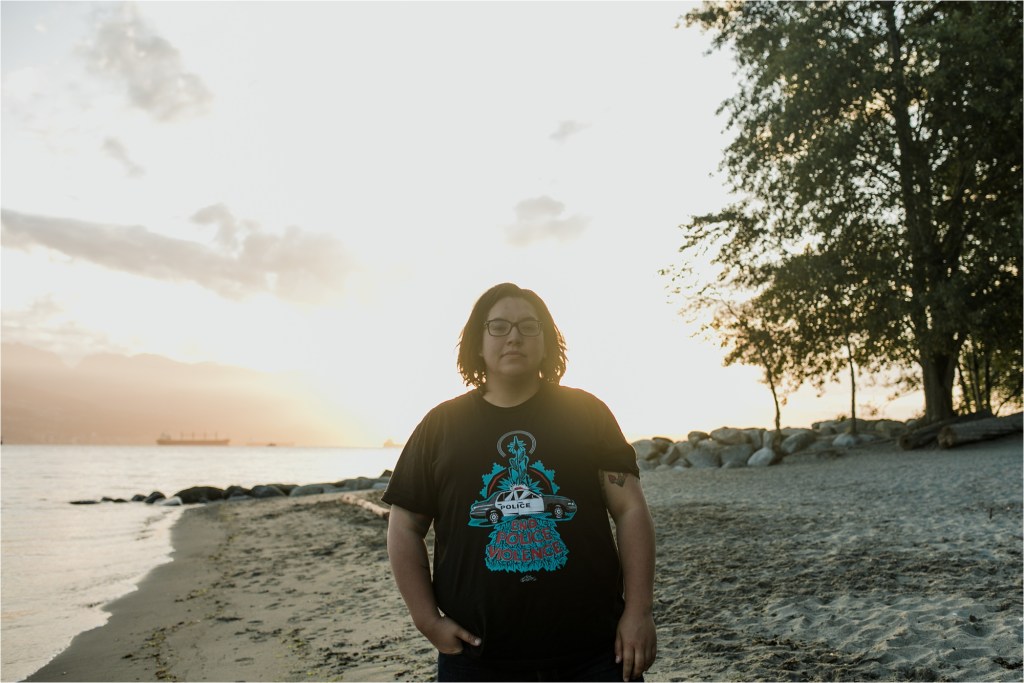
It was my idea to begin with. When I found out that Tenille and I would be in the same city, invited to speak on a panel about our work as both poets and academics (with our other poet/PhD Indigiqueer pigeon fam, Joshua Whitehead), I wrote her the most anxious email I think I have ever written.
“Why did you write it so professional?” she asked later, laughing as always.
“That’s my terrified voice!” and I laughed, too.
We talked about lighting and we talked about what I should wear, and eventually here we are, her with her camera, and me getting naked in the ocean at sunrise.
“Just make me look like Aquaman” I joked. At the time, I’d never actually even seen the (awful) movie, but isn’t Jason Momoa the kind of masculinity every Indigenous man is supposed to strive for? No? (I’m kidding here, but I also need to acknowledge that ideals of Indigenous masculinity still tend to revolve around that rugged looking built brown man sweeping a woman off her feet on the cover of the old romance novels).
Unfortunately, body image problems didn’t end with transition. All of the sudden there are whole new ways to judge myself in regard to how tall or how muscled I am, or how well I “pass” as a man. I will acknowledge here, however, that having experienced “both sides,” the world needs to treat women better. We all do. (Yes, ALL men. Yes, ALL women.)
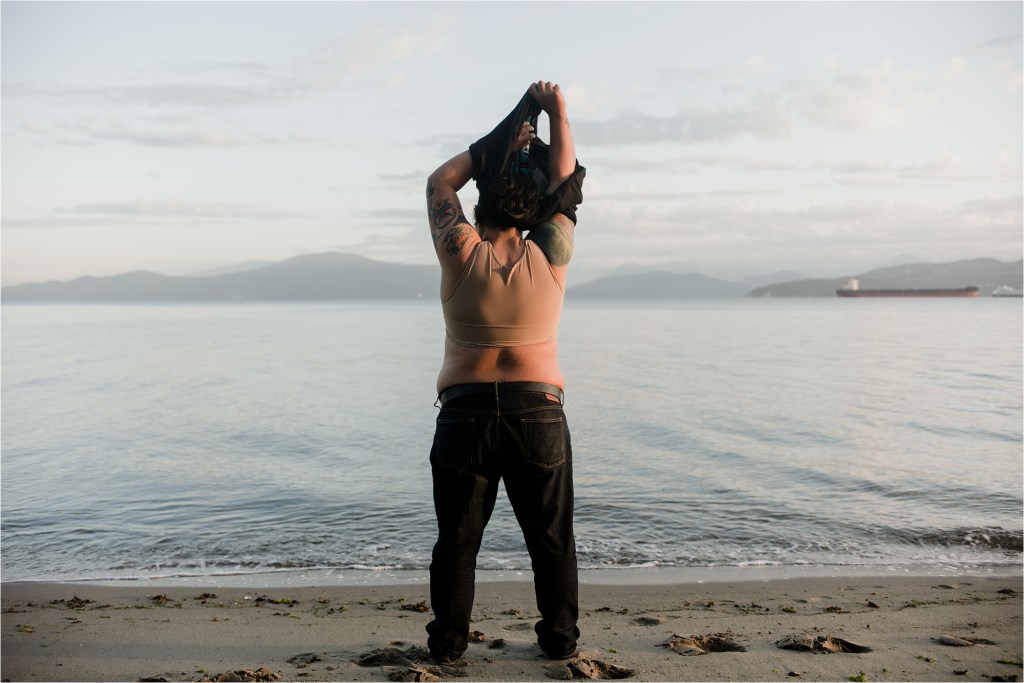
I came out as a transgender man at 29. For me, this felt late. I remember the first moment I ever said it out loud. I was sitting with one of the first trans men I’d ever met in the shade of a truck at our summer ceremonies in Montana. My little brother, who was 16 at the time (and ripped like a superhero), walked by shirtless.
“God, he looks like that just because he’s 16,” my friend said.
“Yeah, it almost makes me want to start testosterone!” I replied. Terrified, I looked at him, and he raised his eyebrows.
“Really?” he asked.
“I don’t know. I’m old!” I replied. He laughed and explained that some people transition when they are in their 70’s. Some wait for their parents to pass on, some wait for partners to go, or for their kids to be grown.
“You’re never too old,” he said.
Once I had made the decision to take my first T shot, I reached out to thank him for this conversation. He didn’t remember the moment, but for me, it was a catalyst having someone affirm and even be encouraging of my trans identity, and how it could manifest in my life. His few simple words opened up a world of possibility for me, just as his existence had when I met him for the first time, a few years earlier. (Thanks, again Aran! I love you!)
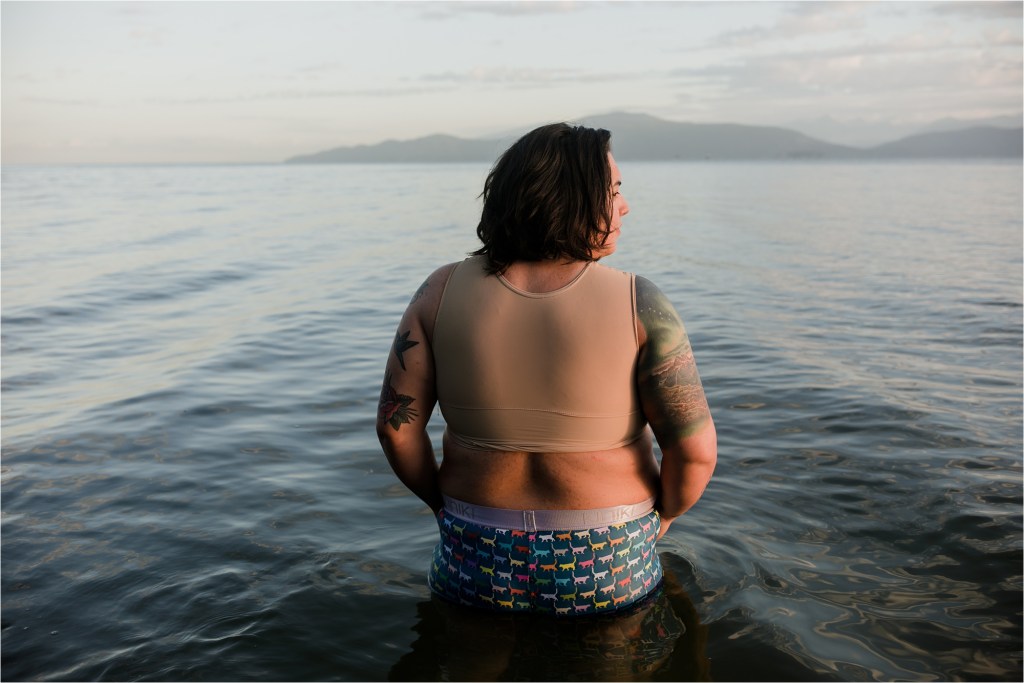
There’s more to this story, of course. Before I came out as transmasculine, I started using the term “two-spirit” to define myself. Again, this came from connections in our summer ceremonies. The first year I started going to this specific ceremony in Browning, Montana, I met a Choctaw medicine woman, who I later found out was two-spirit.
It was feast day, the dancers having come out, the ceremony completed, and a lot of us were beginning to pack up and prepare to head home, when I quietly found a way to ask if I could talk to her.
“I’m just…” I stumble in nervousness. “I… well…” I stammer on. Finally, I shift my eyes up, look her in the eye, and manage to get the words out.
“I’m wondering how you came to identify as two-spirit.” I hold my breath as she begins to laugh. I don’t know what I was expecting, but it wasn’t laughter.
“I’m not surprised we are having this conversation.” She explains. “From the moment you walked up, I saw a two-spirit person struggling with their identity,” she says.
And with that, it’s done. I am two-spirit. It had already been a journey to recognizing myself as both Indigenous, and as queer, and yet I had never felt I could claim “two-spirit.” For me, like the term Elder, it seemed something that the community conferred upon you. Something that was witnessed within you and acknowledged, rather than a title I could give myself.
Of course, there are many definitions of two-spirit, but for me, it wasn’t until she saw me–really saw me, that I began to learn what it meant for me to carry and honour my role.
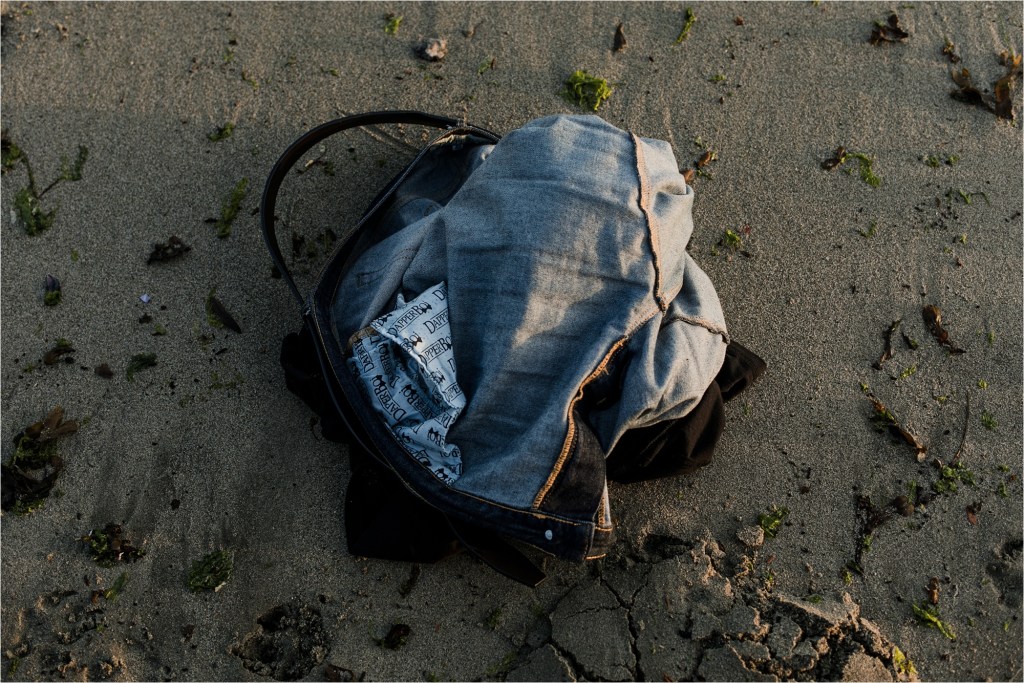
There are parts of this story that I’m not sure how to weave in, like the time I told my friend that I wanted to look like her husband (a gorgeous Blackfoot man, a great dad, and an incredible musician). Or the time at that Blue Jays game where I told my best bro that I was going to start T, and that other time I had a near-panic attack in the men’s deodorant aisle and that same bro texted me back right away with the perfect recommendation (lavender-scented Green Beaver, in case you are wondering) , because he was actually really passionate about the subject and had tried all of them himself.
There’s my younger brother who started T six months before me, and who taught me so much about how we get to decide who we are, even if it changes. There’s the part of the story where I brought a tobacco tie to the nurse who helped me do my first shot, and there’s the only time I went to a full moon ceremony, holding the tiny bottle of testosterone in my hand while I prayed.
Please stay with me, even when I start this medicine. Even when my time stops. I don’t want you to think I’m turning my back on you. I want to keep our connection.
I am in a community lodge, surrounded by women and 2S folks around the fire. I am begging the moon not to leave me. The gender binary has consumed my ability to understand that the moon is not judging me; I am. The moon still shows her face to me. The moon still holds me like the tides. I realize that a grandmother remains a grandmother, whether her grandchild is girl, or boy, both, or neither.
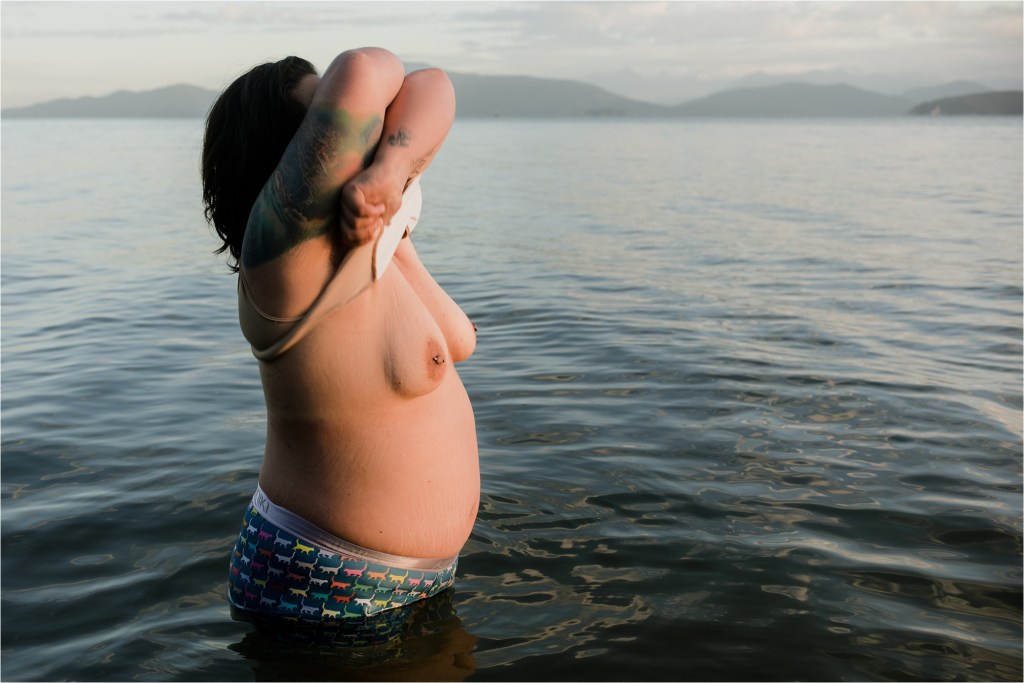
There are parts of this story, too, that I don’t always want to tell. Tenille and I often talk about how so much Indigenous literature focuses only on trauma, and we want to showcase instead NDN love, NDN joy, NDN pleasure. But here I am on a platform made for Indigenous women, and part of my story is that I lived for most of my life, defined as an Indigenous woman. As I told my “white” dad (the one who raised me), once, “just know that you had an Indian daughter, and all the things that you read about happening to Indian women, they happened to me, too.”
A couple months before we met to take these photos, I did a workshop on two-spirit resurgence at Yaqan Nukiy. This was the first time I had talked about who I am and what it means to be 2SQ (an umbrella term to denote Indigenous people who live outside of the gender binary and/or heteronormativity) in my own nation, in my own territory, with other Ktunaxa people.
One of my teachers, who has led many workshops herself, asked the hard question that I knew at some point would come up. We are communities and nations ravaged by sexual abuse, and she shared her own story of abuse at the hands of a woman, and then asked “does that have anything to do with…. all this?” waving her hand to my flip chart where I had written out all the words we could think of that fall under the 2SQ umbrella.
“First off: No.” I want to be very clear about this. Abuse does not make anyone gay, trans, two-spirit, or queer (and/or anything in between). And being 2SQ does not make us abusers.
I had prepared for this question, because I had to answer it for myself when I was still deciding how my transition would look. And at one point I found myself explaining to a friend who had the same questions about themself. There were tears in both our eyes as I asserted my truth.
The abuse didn’t make me trans. I believe that instead of making me this way, the abuse I faced, the molestation at 12, the rapes at 15, 17, 21…I believe that those things stopped me from being able to know who I was. They didn’t cause this. Those things defined me as woman. They defined me as Indigenous woman. I had no choice. White men saw me as consumable. Disposable. They took me away from myself. I had to leave my body. I couldn’t live here anymore. The alcohol helped with that, but when I began to heal, when I got sober, when I found a way to be in this body, even for a moment, that’s when I began to see. That’s when I knew what I’m sure I would have always known if they hadn’t taken me away from myself. That’s when I saw what I had been running from. That’s when I began returning.

There’s also a part of this story that I don’t really know how to talk about. I don’t know where it fits, and yet, I know that in some ways, when Tenille was taking these photos, it was still the only story.
On July 4, 2018, our mom, Carol Edelman Warrior, died. She was the woman who gave me the name Smokii. She was my best friend for a long time before she became my mom. When I talked to her about transitioning, the thing she worried about most was my role in our family, in our story, and in our ceremonies. She was always thinking about how we learn our roles. She wanted to make sure I knew how I would learn what it meant to be son, brother, nephew, uncle, maybe one day, even dad.
When she died, I was the only one who had been through all the stuff that comes after–the funeral home conversations, the decisions about caskets and flowers, the phone calls, the bills. I tried my best to help my family through it and shouldn’t have been surprised when they asked me to write the obituary.
“You’re the poet,” one of my brothers said.
We’re in a Pizza hut in the-middle-of-nowhere, Montana. I’m a scribbling a few notes on a small hotel pad. I’m asking each kid how they want their names and partners and children’s names written. I’ve got all seven of the kids down when one of them says, “and you…Smokii Sumac.” I look at them with tears in my eyes as I write down my own name. The name she and dad gave me. There was never an official adoption or anything, but in that NDN way, it was done. We have been, and always will be, family.

Something most cisgender people won’t know about, when they read this story, is the wealth of knowledge and connection that the internet has given transgender people (and Indigenous people, for that matter, and I’m sure there are many other people who face different forms of oppression who can say the same.) In deciding to transition, I, a researcher by trade and also by passion, must have read everything there was to read about FTM (female-to-male) transitions. My doctor even printed off some pages for me from the secret MD log-in research pages, because she recognized my need to know everything as important preparation for the medical transition I was about to start.
One thing that kept coming up for me, over and over again, was that I didn’t see anyone like me. For a long time, in fact, I thought I couldn’t be a man, because the only men I knew (and the only men I saw transitioning online) were white men.
It wasn’t until I began meeting and forming relationships with Native men (men who I now call my uncles, brothers, and my dad), and as mentioned already, with Native trans men, that I could begin to envision a future for myself.
For those familiar with the trans internet, you’ll know about those “this is my voice 1 month on T” videos. I made a few of them in the beginning. I never posted them, but I made them because when I was searching, and searching, and researching, and searching, those videos helped me. I wanted to see them all. All the before and after shots. All the top surgery photos, all the changes documented in minute detail, week by week, month by month. I made my own videos in the beginning because no matter how deep my searches went, I never saw myself. I never saw a body like mine.

When I was struggling with the decision to medically transition, another trans pal asked, “Well, how do you see yourself when you are an old person?”
“What?” I asked, incredulous.
“You know, like when you think about getting old… what do you see?” they repeated.
And it was in that moment I realized that I had never considered getting old. “Hell, I didn’t even think I’d make it to 22,” I told them, and they encouraged me to start imagining new futures, because it might help me with my decision. It was a healing practice to start thinking about where I could end up someday, old and wrinkled, tattoos and all, and probably still wearing my red plaid jacket.

Back on the beach, I’m slowly taking off layers. I get into the water and turn to face Tenille. “Oh. My. God.” I say, and point to the sky. Tenille looks up just as a huge bald eagle flies over us, so close I can nearly feel the air from its wings. “See? I told you!” she laughs. “Be an Eagle!”
I remember Leanne Simpson saying once “Eagles are NDN Ativan.”
In that moment, with such little sleep, with so many big belly laughs, with Tenille bossing me around, and an eagle blessing us (“real sacrit”), I am fully in the moment. I am fully myself. I take a breath and continue to find space here in my body, present, and witnessed, just as I am.
And when Tenille sends me the pictures, I am stunned into silence. I hold them close for a while before sharing them with two trusted friends. Tenille’s work is medicine because she sees us. Too many people still want to photograph the Indians with their own Edward Curtis-like agenda. Dress us up with the beads and the feathers to document a “vanishing race.”
Tenille doesn’t just want to take our picture. She loves us. Beaded and feathered or with nothing on, she knows we are here—very much alive—knows that she’s capturing a moment that is giving way to a future. I was terrified to ask her, because I knew it would be real. I knew it would be medicine.
“Trust me,” she said.
“I do,” I replied. “I wouldn’t do this with anyone else.”

When I look at these pictures, I see myself. I see a Ktunaxa two-spirit person. I see the grief of losing my mom. I see the awe and laughter and hope that eagle carried above us.
And most importantly, for me, no matter what anyone else might say, I see a man. I see an uncle, a brother, a nephew, and I see, maybe for the first time, my mother’s son.
And even though she’s not here physically to see me grow into these roles, I know that she saw me that way, too.
hu sukiǂq̓ukni, Tenille, for also seeing me.
And to you reading this now, thank you for witnessing. I hope that if you are struggling with some part of who you are, there was something in this that gave you hope, and will help you in your own journey to seeing yourself.
❤
Smokii Sumac
Smokii Sumac is a Ktunaxa two-spirit/transmasculine poet and PhD Candidate in Indigenous Studies at Trent University. If you appreciated this post and would like to support Smokii, please donate and/or share his crowdfunding campaign for top surgery which can be found here: https://www.gofundme.com/manage/smokii039s-top-surgery

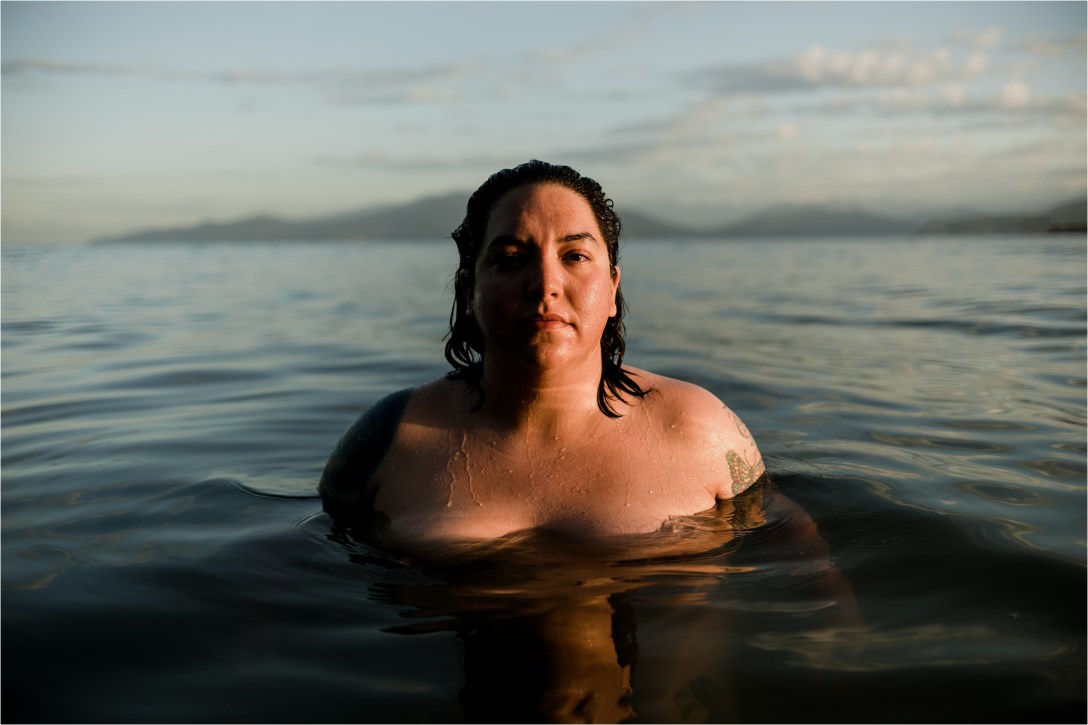
This is so powerful, Smokii – thank you for sharing ❤
LikeLiked by 1 person
😎🤩
LikeLiked by 2 people
I wish I knew myself quite like you know yourself. I strive for this level of self-love in life and to finally see myself.
Very inspiring read! Thank you for sharing with the world.
LikeLike